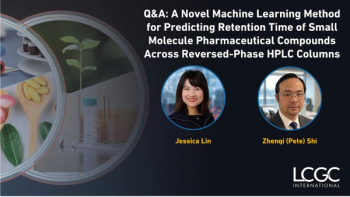
- June 2025
- Volume 21
- Issue 2
- Pages: 7–9
Marking 150 Years: Shimadzu Europa’s President Reflects on Legacy and Innovation
Yoshiaki Hirao, President of Shimadzu Europa GmbH, sat down with LCGC International to share insights into the company’s journey, reflecting on its evolution from a small Kyoto-based enterprise founded in 1875 to a global leader in analytical instrumentation.
Founded in 1875, Shimadzu Corporation is celebrating its 150th anniversary this year—a milestone that reflects a long‑standing legacy of innovation and cross-disciplinary work in analytical chemistry. In honor of the occasion, Yoshiaki Hirao, president of Shimadzu Europa GmbH, spoke with LCGC International to reflect on the company’s journey, offer his top career advice, and share insights into what’s ahead for the next chapter.
Q: Congratulations on your 150th anniversary! How is Shimadzu celebrating this achievement, and how do these celebrations reflect the company’s legacy and vision for the future?
As you know, our company’s motto is contributing to society through
science and technology, which has remained unchanged since our
founding. I believe this commitment is a key reason we are celebrating our 150th anniversary. To show our gratitude to customers around the world who resonate with this motto and support us, we are holding several ceremonies in various locations. At these events, we will showcase commemorative models of liquid chromatography (LC), current LC and gas chromatography (GC) instruments, along with traditional Kyoto crafts. This reflects our founder’s background in decorative items for Buddhists and serves as a tribute to his legacy.
Q: Looking back over the company’s 150-year history, what innovations or breakthroughs are you most proud of? How has Shimadzu’s technology evolved to meet the changing needs of science and industry?
I hold great respect for the reason our founder established this company and the breakthrough it represents. To explain this, I must touch on a bit of Japanese history.
Our company was founded in 1875, but just before that, in 1868, Japan underwent a significant transformation from the Edo period, which lasted for about 260 years, into the modernization of the Meiji era. During this time, the political center moved from Kyoto, where the emperor resided, to Tokyo, leading to a significant population decline and economic concerns in Kyoto. Our founder, Genzō Shimadzu Sr., was based in Kyoto, and he believed that science and technology would create new industries and so aimed to revitalize the local economy by establishing a company in Kyoto to support these advancements. His entrepreneurial spirit was truly a commitment to contributing to society through the development of science and technology, representing a breakthrough not only for our company but also for Japan at that time.
Another episode that I particularly admire is in 1896—just 11 months after the discovery of X-rays—Shimadzu became the first person in Japan to successfully perform X-ray imaging. This achievement marked a significant milestone, demonstrating our contribution to the advancement of science and technology in the medical field.
However, what I want to highlight is what came afterward. As you know, X-rays can be harmful to the human body if not handled correctly. Recognizing the need for specialized knowledge and skills for the safe use of X-ray technology, our founder established Japan’s first X-ray technician school in 1900. This school was created to provide education on X-ray technology and to train professionals in medical settings, and it continues to exist today.
Q: As you look ahead, what are some of the key areas where Shimadzu is
focusing its research and development efforts? Are there specific application areas or technologies where you see the most opportunity for growth and innovation?
As we look ahead, one of the key areas we are focusing on is the health of people and the planet, which is a universal and perhaps eternal theme around the world. We aim to support our customers who are working daily toward this goal, and to achieve it together. Specifically, our main theme includes the development of analytical technologies for biopharmaceuticals and personalized medicine, the creation of new analytical methods related to environmental protection, and innovations in technologies for food quality control and safety assessment. However, we believe that it will be increasingly important not only to develop these methods but also to work toward their implementation in society.
Q: What new market areas is Shimadzu actively exploring, and where do you anticipate the greatest demand for cutting-edge analytical solutions in the coming years?
To reiterate my previous answer, we are exploring market areas related to life sciences, particularly in biotechnology and pharmaceutical development, and growth in the environmental analysis market.
There will also be a rising demand for food safety and quality control.
Q: Your customers rely on Shimadzu’s technologies to solve complex analytical challenges. What are some of the most common pain points or hurdles they face, and how is Shimadzu working to address these challenges with new solutions or innovations?
Let’s take supercritical fluid chromatography (SFC) as an example. SFC is a powerful technique that allows for the rapid and efficient separation of compounds, particularly in the analysis of pharmaceuticals, natural products, and food safety. Its ability to use environmentally friendly solvents also aligns with the growing demand for sustainable analytical practices. In addition to traditional analytical methods, we leverage our extensive product lineup to collaborate with our customers on various innovative approaches. Together, we work on developing new techniques that meet their specific needs and challenges.
Q: How will artificial intelligence (AI) affect the chromatography community in the short-term and the long-term?
In the short term, as we have already introduced with our peak intelligence feature, we are advancing the efficiency and automation of data analysis, enabling rapid acquisition of analytical results. This improvement enhances both accuracy and productivity in analysis in the long term. In December 2021, we began validating the utility of a prototype autonomous experimental system called Autonomous Lab, developed in collaboration with Kobe University, utilizing both robots and AI. This system aims to optimize the production process of smart cells and management.
Based on the experimental result obtained, AI can propose new experimental conditions for subsequent analysis, creating a fully autonomous experimental system. This approach allows us to verify analytical methods from a complex competency perspective without relying on human integration or experience, enabling efficient progress in research. I believe we are moving toward an era where such analytical systems will become widespread.
Q: What’s the best piece of leadership advice that you have received in your career?
The priority must first be a focus on the customer’s needs, so we can find ways to improve our business and our products and services.
Yoshiaki Hirao is president of Shimadzu Europa GmbH. He joined Shimadzu Corporation in April 1991 and was assigned to the Analytical Measurement Sales Division at the Hiroshima Branch. In April 2023, he assumed the role of corporate officer at the Head Office and president of Shimadzu Europa GmbH.
Articles in this issue
6 months ago
Vol 21 No 2 The Column June 2025 Europe Link6 months ago
Living in America: analytica USA6 months ago
Liner Volume Matters6 months ago
PFAS in Food AnalysisNewsletter
Join the global community of analytical scientists who trust LCGC for insights on the latest techniques, trends, and expert solutions in chromatography.




